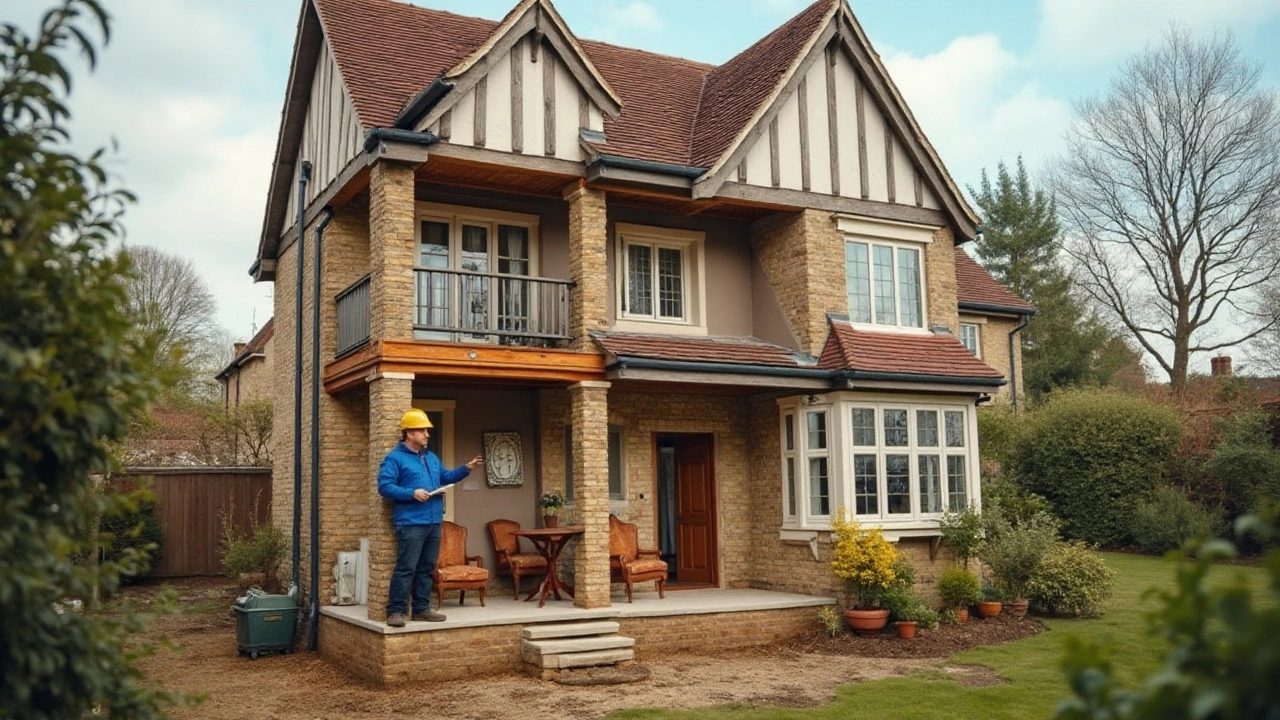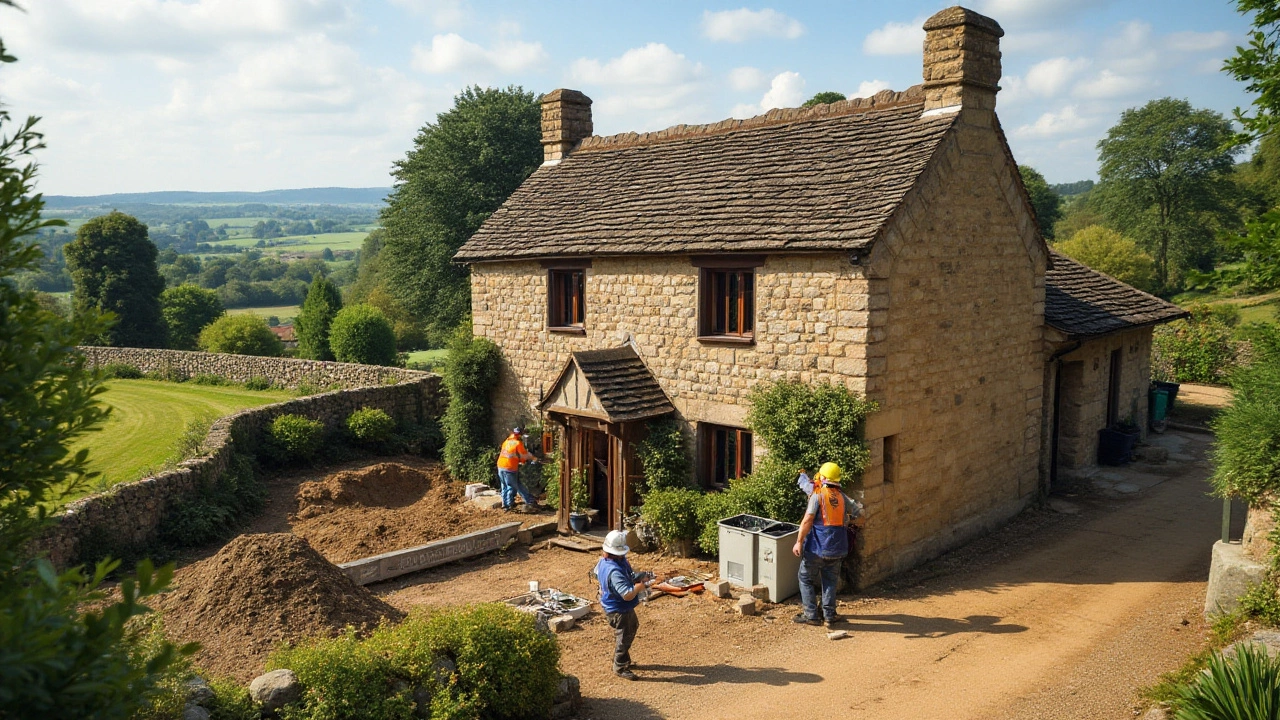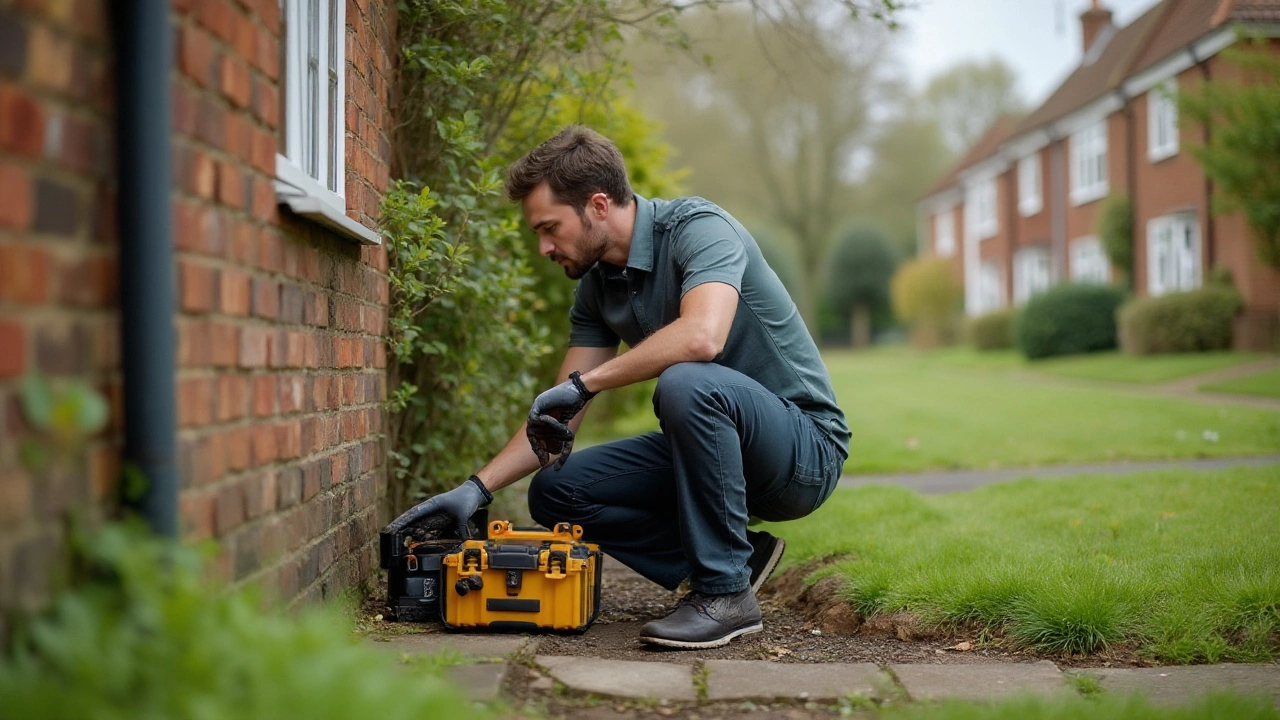Foundation cracks can be a daunting discovery for any homeowner, as they often raise concerns about the structural integrity of a house. Whether you've stumbled upon a tiny fissure or a more pronounced gap, addressing the issue is crucial to prevent future damage.
One of the most common dilemmas faced by property owners is deciding whether to tackle these cracks from the inside or the outside. Each approach has its merits and can be more suitable depending on certain conditions.
This article dives into the nuances of both methods, providing you with a better understanding of what might work best for your unique situation. Let's explore these options and equip you with the knowledge to protect your home effectively.
- Understanding Foundation Cracks
- Why Repair Methods Matter
- Inside Repair Techniques
- Outside Repair Strategies
- Choosing the Right Method for Your Home
- Preventive Measures and Maintenance Tips
Understanding Foundation Cracks
When it comes to the structural stability of a home, addressing foundation cracks is paramount. These fractures occur due to a variety of factors, each contributing to potential long-term damage if not treated properly. Understanding the origins and characteristics of these cracks is essential for any homeowner or builder.
Foundation cracks can arise from natural settling, changes in moisture levels, or external pressures such as tree roots and nearby construction. Settling is a common cause, as houses adjust to the soil and climate after being built. However, not all cracks are equal. Hairline cracks, often seen in freshly poured concrete, typically don't pose a structural threat. Yet, larger gaps can indicate significant problems and demand immediate attention.
Recognizing the difference between cosmetic and structural foundation cracks requires careful inspection. Structural cracks are usually wider than three millimeters, run vertically or diagonally, and often remain visible through surface finishes. If water seepage is observed, it's likely that the crack compromises the foundation's integrity. Seasonal changes can exacerbate foundation issues, particularly in areas prone to freeze-thaw cycles. The expanding and contracting of soil can place immense pressure on the foundation, leading to more pronounced fractures.
"The key to maintaining a healthy home begins with understanding and addressing foundation issues at their earliest stages," says Jeff Skoll, a renowned structural engineer.
Interestingly, the type of foundation material plays a role in how cracks develop and propagate. Concrete, for instance, tends to crack more easily than materials reinforced with steel or fibers. On the other hand, concrete's durability and widespread use make it a common choice for builders, highlighting the importance of proper curing and reinforcement techniques. The climate also cannot be underestimated as a factor. Homes in areas with significant rainfall or varied temperatures often face unique challenges. Preventative measures, such as proper drainage and landscaping, can alleviate some of these environmental pressures.
Table of Key Factors Influencing Foundation Cracks:
| Factor | Impact |
|---|---|
| Soil Type | Expansive soils exert pressure |
| Moisture Levels | Swelling and shrinking of soil |
| Construction Quality | Impacts initial integrity |
| Environmental Conditions | Influence crack propagation |
To properly diagnose the severity and cause of foundation issues, it is often advised to consult with professionals who can perform comprehensive evaluations and suggest tailored solutions. For homeowners keen on monitoring their property's health, regular checks for external signs of foundation trouble, such as sagging floors or stuck windows and doors, can provide early warnings. With a proactive approach to understanding and addressing foundation cracks, the lifespan of your home can be significantly extended.
Why Repair Methods Matter
Foundation cracks are more than just cosmetic issues; they pose potential risks to the structural stability of a home. Selecting the correct repair method is crucial because it determines how effectively these cracks will be addressed, impacting the longevity and safety of the building. The choice between inside and outside repair methods hinges on various factors, including the type of foundation, soil conditions, and even the local climate. Each approach offers its distinct advantages and limitations, which makes understanding them essential for any homeowner.
Several factors dictate why one might choose an inside repair over an outside one, or vice versa. Inside repairs are typically less invasive and can often be completed more quickly. They are particularly beneficial in situations where outdoor excavation isn't feasible, such as in urban areas with buildings in close proximity. However, they may not address underlying causes like water infiltration from outside the foundation. On the other hand, outside repairs usually involve more comprehensive solutions, such as waterproofing barriers and foundation sealing, which can prevent water from entering altogether.
It's important to emphasize that neglecting appropriate repair methods can lead to escalating problems. If foundation cracks are not appropriately fixed, it might result in water leakage, increased humidity inside the home, and even more serious structural concerns. According to a report by the National Association of Home Builders, 1 in 30 homes in areas with expansive clay soils suffers from significant foundation problems — a sobering statistic that underscores the critical nature of picking the right repair strategy from the start. Additionally, employing the wrong method can sometimes even exacerbate the issue, leading to costlier repairs down the line.
"Neglecting minor foundation issues today will only lead to major headaches tomorrow," says David Greenberg, a renowned structural engineer. "Choosing the right repair method based on thorough assessment is key to safeguarding your most valuable asset."
Understanding why repair methods matter in the context of your home's specific circumstances is crucial for any property owner. Whether the foundation cracks are caused by natural settling, soil erosion, or water damage, the key is to diagnose the root cause accurately and select a strategy that effectively tackles that issue. Consulting with a foundation repair specialist can often provide valuable insights into which method is best suited to your home, ensuring that you maintain a safe and secure living environment.

Inside Repair Techniques
Addressing foundation cracks from the inside is often considered a first line of defense, primarily for its accessibility and cost-effectiveness. When tackling smaller cracks, injecting polymers or other sealants into the crevices can be an efficient solution. These materials are designed to expand once inside the crack, filling any voids and providing a watertight seal. This method is particularly effective in areas where moisture is a concern, as keeping water out is pivotal in maintaining the foundation's integrity.
One common technique involves the use of epoxy or polyurethane injections. Epoxy is highly beneficial for its strength, often used when structural cracks are found and a durable bond is needed. Polyurethane, on the other hand, is more flexible and can accommodate any potential movement in the foundation, making it a favored option for non-structural cracks where a little flexibility is a plus.
Another approach is the concrete patching method, where cracks are cleaned and then filled with a fresh mortar mix before being smoothed down to blend seamlessly with the rest of the wall. This not only repairs but also fortifies minor damage before it escalates. According to the Foundation Repair Association:
For quick repairs, injecting cracks with an epoxy or polyurethane compound offers an effective and straightforward solution, particularly for minor and non-structural cracks. However, always consult a professional engineer if there are signs of significant movement or damage.
An important factor to consider is the crack's size and direction. Vertical cracks, which are more common and less serious, might just need simple attention. However, horizontal cracks often suggest a more severe issue and may require professional assessment. Interestingly, a survey conducted by the National Association of Home Builders found that about 60% of homeowners who opted for inside repair methods reported improvement within a few months, showcasing the effectiveness of these techniques, especially for minor issues.
For an integrated solution that goes beyond sealing, some professionals recommend combining inside repairs with moisture control systems. This includes installing interior drainage and sump pump systems, which direct water away from the foundation, reducing pressure and preventing future issues. Though this might sound extensive, it's a viable long-term strategy for those living in particularly wet or flood-prone areas.
Using inside repair techniques offers a practical, often less intrusive way to manage cracks, enabling quick action. Yet, while these methods provide a temporary fix or supplement external efforts, ensuring a comprehensive approach tailored to your home’s needs is crucial. Homeowners keen on tackling foundational issues themselves should weigh these options carefully and consider expert advice for peace of mind and enduring results.
Outside Repair Strategies
Tackling foundation cracks from the outside involves engaging directly with the root cause, which often lies beneath the surface soil that surrounds your home. The outside approach can be more intensive, but it is essential for certain types of damage that stem from external pressures. One common method involves excavating the ground surrounding the affected section of the foundation. This excavation allows for several crucial repair steps to be executed properly. Excavating opens up the opportunity to not only repair visible cracks but to also install new drainage systems to manage water flow, which is often a primary culprit behind foundation issues. Correcting the drainage can prevent future water-related damage.
Once the area has been exposed, professionals thoroughly clean the cracked portion of the foundation. This preparatory step is vital to ensure that any filler materials or sealants properly adhere to the existing foundation surface. After cleaning, a waterproofing membrane is applied to the exterior wall. This barrier acts as a shield, preventing water from penetrating the foundation in the future. An interesting fact to consider is that innovative materials like flexible polymers are often used in this membrane to accommodate natural movements of the structure without cracking again.
Applying a sealant is another vital step, but in outside repairs, the emphasis is on using durable sealants that withstand weather conditions over time. The choice of sealant can vary depending on the climate; for example, regions prone to freezing weather might require different materials compared to warmer, drier areas. This contextual consideration makes outside repair both art and science, necessitating a keen understanding of the local climate’s impact on building structures.
Frequently, these exterior methods are complemented by additional structural reinforcements such as underpinning or hydraulic pushes. These techniques serve to bolster the foundation's strength and provide further assurance against future settling or cracking. Interestingly, underpinning can also be a solution if you’re considering house expansions in the future, providing enhanced stability.
"Exterior waterproofing is not just a fix, it is an investment in the resilience and longevity of your home’s foundation," advises Susan Fisher, a renowned structural engineer.By addressing issues from the ground up and solving external environmental problems, homeowners can effectively safeguard their properties for the long haul.
While an outside approach is comprehensive, it's critical to gauge whether such an undertaking is warranted for the particular types of foundation cracks experienced. The cost, although relatively higher, often results in lasting results, and peace of mind is a worthwhile trade-off. In some cases, integrating these strategies with interior methods can provide an even more robust solution, creating a formidable defense against all potential threats to your foundation.

Choosing the Right Method for Your Home
When it comes to addressing foundation cracks, selecting the most effective method often involves a mix of understanding the type and severity of the damage, the climate in your area, and the characteristics of your home's foundation. Making the right choice can ensure that your repair is both durable and cost-effective. An inside repair approach might be suitable if cracks are minor and there's minimal risk of water infiltration. This is often the case with shrinkage cracks that occur as the concrete cures over time, which are typically cosmetic in nature. Homeowners in dry climates, where water pressure is less of a concern, may find inside repairs provide adequate protection.
On the other hand, if your property is exposed to heavy rainfall or high groundwater levels, an outside repair might be necessary. This method addresses the root causes like poor drainage or soil pressure against the walls, which can exacerbate foundation issues. By excavating around the foundation, professionals can apply waterproof membranes or drainage solutions to redirect water away from the home, creating a more comprehensive fix. Notably, the North American Concrete Alliance states,
Exterior foundation repairs, while often more labor-intensive, provide long-term assurance against water penetration by addressing the problem at its source.It's important to weigh these options carefully, as the upfront investment in exterior work may save you substantial amounts on future maintenance costs.
Homeowners are also encouraged to consider hybrid solutions that combine both inside and outside repair techniques to maximize the effectiveness. Working with experienced foundation specialists who understand local soil conditions and climate impacts can help guide your decision, ensuring a method is chosen that does more than just treat the symptoms. Instead, it addresses the underlying issue, preventing it from recurring in the future. For those interested in calculations, here’s a breakdown of possible cost ranges: Inside repair costs typically vary between £800 and £2,500, depending on the scope, while outside repairs can start from £3,000, reaching as high as £10,000 for extensive work. Here's a snapshot of these costs:
| Repair Type | Typical Cost Range |
|---|---|
| Inside Repairs | £800 - £2,500 |
| Outside Repairs | £3,000 - £10,000 |
Always keep in mind that each home presents its own unique challenge when it comes to foundation cracks. The soil type, age of the structure, and history of foundation issues all play a crucial role in choosing the method that best fits your needs. By methodically assessing these factors and balancing them against your budget and long-term goals, you can protect your home's value and avoid costly damages down the line.
Preventive Measures and Maintenance Tips
Don’t wait until foundation cracks require immediate repair. Embrace preventive measures and regular maintenance to protect your home from potential hazards. One effective way to preserve the foundation is to manage water flow around your property. Ensuring proper drainage is essential. When water accumulates near the base of your home, it can lead to soil expansion and contraction, creating undue pressure on the foundation. To mitigate this, ensure gutters are clear, and downspouts direct water at least five feet away from the house.
Landscaping can also play a vital role in maintaining a healthy foundation. Planting trees and large shrubs at a safe distance prevents roots from infiltrating and potentially weakening the structure. Opt for plants with less invasive root systems near the foundation. Additionally, maintaining consistent soil moisture levels around your home can help, particularly in regions prone to droughts or heavy seasonal rains. Using soaker hoses during dry spells can stabilize soil movement, protecting the foundation from unexpected shifts.
Routine Inspections and Repairs
Routine inspections are critical to preventing foundation damage before it becomes severe. It is advised to perform a comprehensive inspection at least twice a year. Start by checking for any surface changes such as new foundation cracks or signs of moisture intrusion on both exterior and interior walls. Keeping an eye out for symptoms such as sticking doors, uneven floors, or cracked tiles can be early indicators of foundation issues.
"An ounce of prevention is worth a pound of cure," Benjamin Franklin wisely noted, a sentiment that rings especially true with home maintenance.
When minor cracks are detected early, they often require straightforward fixes, saving you the cost of extensive repairs down the line. It’s highly beneficial to consult a professional if any worrying signs arise, as they can provide a detailed assessment and recommend repairs if necessary. Remember, applying proactive maintenance strategies can substantially extend the life of your foundation.
Adapting to Climate and Soil Conditions
Adapting preventive strategies to your specific climate and soil conditions can also minimize the risk of foundation problems. For instance, homes built on clay-rich soils need distinct preventative measures compared to those on sandy soils. Clay tends to expand and contract with moisture levels, making consistent moisture maintenance crucial. Conversely, sandy soils drain quickly and require different landscaping considerations to avoid erosion around the foundation.
Apart from soil types, pay attention to temperature changes and seasonal cycles. Cold climates, where freeze and thaw cycles are common, pose additional challenges. Insulation around the foundation can help mitigate this impact, reducing direct exposure and helping maintain stable conditions. Ultimately, understanding your local environmental conditions will aid in tailoring your foundation repair and maintenance strategies to be more effective.
